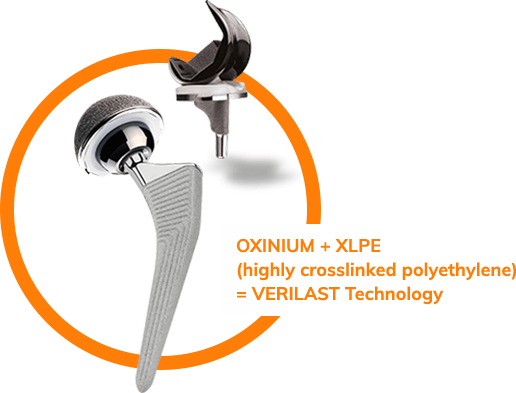Verilast Implant Technology

If knee or hip replacement is in your future, you've come to the right place to learn about one of the truly significant advancements in joint replacement materials in the past 20 years, VERILAST knee and hip technology.
Verilast is the combination of Oxinium and highly crosslinked polyethylene (XLPE). Oxinium is an oxidized zirconium material that has the smoothness and reduced wear of a ceramic with the toughness of metal. Its material properties are ideal for those patients who have known allergies to nickel, cobalt or chrome since Oxinium does not contain any significant amounts of these potentially allergic metals. XLPE is the plastic piece of the joint that is specially processed to last longer with reduced wear, especially when it’s used in combination with Oxinium.
It's important to remember that not every joint implant is the same. VERILAST knee and hip technology directly addresses two of the most commonly cited concerns associated with joint replacement implants:1,2
- Implant wear
- Implant fracture
Whether or not to undergo knee or hip replacement surgery is a very important decision. No matter how statistically safe and successful joint replacement surgery has proven to be, every surgery has risks. Before making any surgical decision, conversations should take place with your family, your primary care doctor and your orthopaedic surgeon to make sure that knee or hip replacement with VERILAST Technology is the right course of action for your particular situation.
Important safety notes
Individual results of joint replacement vary. Implants are intended to relieve knee and hip pain and improve function, but may not produce the same feel or function as your original joints. There are potential risks with knee replacement surgery such as loosening, wear and infection that may result in the need for additional surgery. There are potential risks with hip replacement surgery such as loosening, fracture, dislocation, wear and infection that may result in the need for additional surgery. Longevity of implants depends on many factors, such as types of activities and weight. Do not perform high impact activities such as running and jumping unless your surgeon tells you the bone has healed and these activities are acceptable. Early device failure, breakage or loosening may occur if you do not follow your surgeon's limitations on activity level.
References
- Australian Orthopaedic Association National Joint Replacement Registry Annual report. Adelaide: AOA; 2012.
- Testing concluded at 45 million cycles. ISO 14242-1 defines test completion at 5 million cycles.
For more information visit www.sncontent.com


